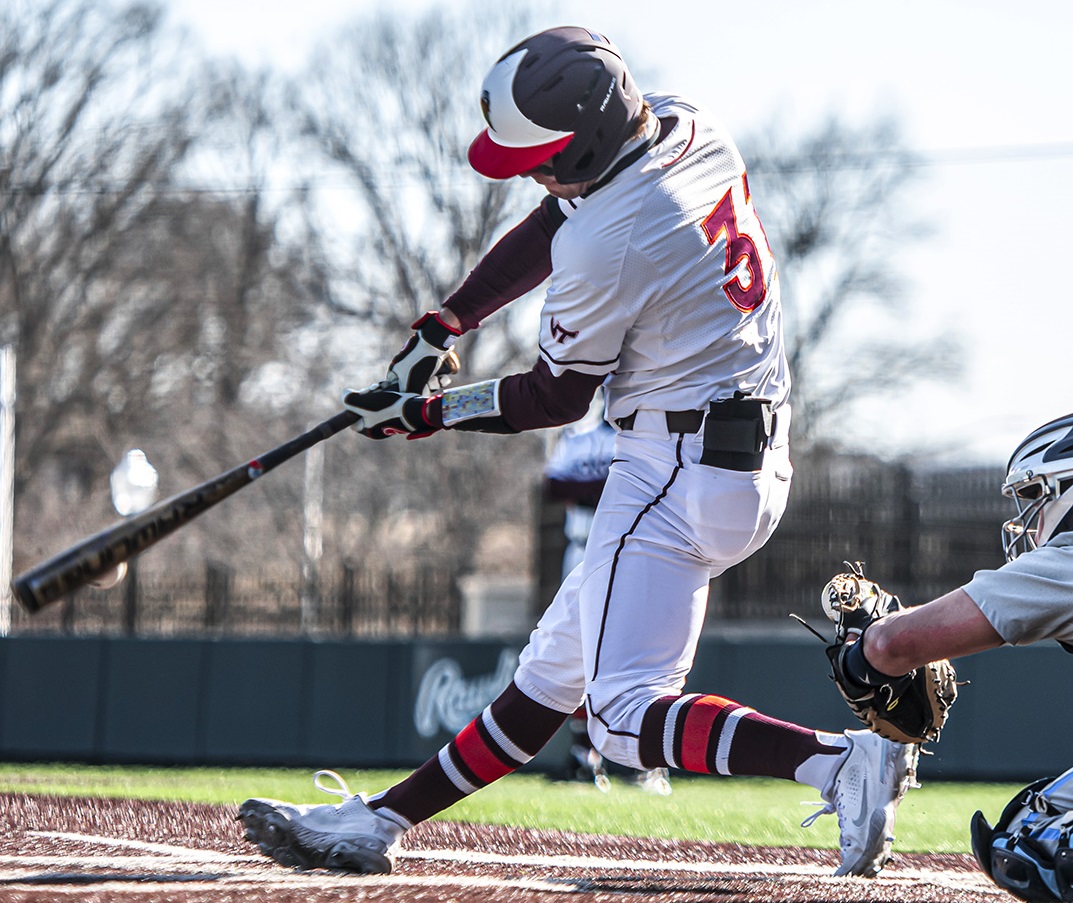
We sat down with director of player development Kyle Sarazin to talk about the analytics and new technologies that Virginia Tech baseball is using in the 2021 season. Last week, we looked at the big picture of the resources that have been dedicated to Hokie baseball to make it all possible. In part two this week, we will look at specific ways that the analytics and technologies are used by Sarazin to give the Hokies an advantage.
In the modern game of baseball, certain buzzwords have come to dominate the sport. Now when watching a broadcast of a baseball game, you’ll hear the announcers talk about the spin rate of a pitch or the launch angle of a home run.
We hear this lingo, but oftentimes even the die-hard fan would have trouble explaining what the ideal range is for any of these metrics. This is exactly where Virginia Tech’s Director of Player Development Kyle Sarazin provides his expertise.
“It’s a conversation that I need to be the liaison between the technology and the players,” Sarazin said. “It’s an education process with these guys with the analytics, and all of a sudden when we get Trackman, and we have hitting Rapsodo in our cages now. We have a TV in the cages with Rapsodo, so these guys are getting real-time feedback. Every rep is meaningful, so we try not to have any empty reps in our program. They have the TrackMan on the field for their BP’s, so they can actually visualize it.”
It’s this visualization process that leads to results. If Sarazin tells a batter to hit a ball 95 miles per hour at a 15-degree launch angle, they likely won’t know what that means. However, if he tells them to hit a line drive over the second baseman’s head, it’s something they can understand. Then, they can strive for that sort of hit, and with the feedback from the technologies they can see that it would match that desired 95 mph exit velocity at a 15-degree launch angle.
“That’s the blend of it all, these guys see numbers and they want to hit certain thresholds, but they don’t know what it looks like,” Sarazin said. “That’s where I come and be the liaison. I tell them, ‘This is the approach. We can’t swing uphill all day because all of a sudden we’re going to swing and miss more.’ That’s how it is.”
It’s the same way on the pitching side. The Hokies use Rapsodo and slow motion cameras to capture and create a visualization process for all the pitchers. Reigning Cy Young Award winner Trevor Bauer is the one who revolutionized this pitch design enhancement to remake his slider with the use of these technologies in a data-driven lab.
“I think that’s a big reason why we’re one of the top two or three teams in the ACC with strikeouts right now,” Sarazin said. “Coach [Ryan] Fecteau and I have a really good understanding of how guys’ stuff works and playing to their strengths. Where their fastballs play in the zones for swing-and-miss as well as what creates good separation with their other pitches, movement wise.
“As we get the pitching lab set up here, that’s going to be a really cool space for guys, and it’s just going to keep building and building and building as we’re here longer and continuing to do our thing.”
There’s also the innovation of a new technology that Virginia Tech baseball has added this year to continue refining the team’s offensive approach at the plate. It’s the Win Reality virtual reality headset.
“We actually got with a few teams at the Power Five level who had it before, and they were saying that after they started they scored 2.5 more runs per game,” Sarazin said. “That’s when we said, ’OK, we have to make this investment.’ For us, it’s been awesome so far.”
@WinReality in the hotel lobby to get our guys some virtual ABs vs the arms from Clemson we are expecting tonight. @HokiesBaseball trying to get every advantage we can get using technology pic.twitter.com/KS5aDRcu7q
— Kyle Sarazin (@ksarazinVT) March 19, 2021
Using an Oculus Quest 2 headset, the Hokies can simulate pitchers from opposing teams in their hotel rooms, on the bus, and even in the dugout pregame. All that’s needed is a WiFi connection that Sarazin always keeps handy with a hotspot on the road.
From there, the Hammerin’ Hokies become fully immersed in this world.
“It’s stuff that the casual or the strong fan really doesn’t see,” head coach John Szefc said. “It’s pretty dramatic what that is. When you can basically see what you’re going to see later on that day on a headset, it’s something from outer space.”
With Win Reality, Virginia Tech is able to mimic all the arms they’ll be facing in the ACC. The simulated pitcher will use the exact same mechanics, pitching motion, and pitching repertoire of these real-life pitchers.
First ACC weekend means @WinReality comes out. Great to get the boys some ABs before the lights come on in Coral Gables Friday night #BIIB 🧱 pic.twitter.com/p5fLaMuIWe
— Kyle Sarazin (@ksarazinVT) February 24, 2021
“It’s not necessarily about guys hitting the ball, it’s about the zone recognition,” Sarazin said. “You get to track the pitches as they come in. You get to see what each pitch looks like. A lot of guys understand fastball versus off-speed. But how does his changeup look out of his hand versus his slider? How can we identify each of those pitches?”
The Hokies primarily use the Occlusion training mode with Win Reality. In this drill, you see the first 55 feet of the pitch and have to identify which pitch was thrown. Each pitch will move in 3-5 feet, giving you less and less time to pick up the cues to correctly identify the pitch. Sarazin notes the best hitters in the world can get within two inches, a mark that Virginia Tech strives for.
It’s all received positive feedback from the players.
“I enjoy the VR for the timing part of it,” said Gavin Cross, the Hokies’ leading hitter with a .407 batting average. “I don’t ever try to take a swing while watching it. I just like seeing his release point, if he’s got a short arm or long arm, if he hides the ball, whatever it may be. Just hop on there for four or five pitches.”
All of these different technologies are blended together to create a comprehensive gameplan for all the pitchers they’ll be facing in a weekend series. For example, the Hokies were able to beat UNC’s ace Austin Love and Pitt’s ace Mitch Myers because of the scouting report developed through all the programs.
“We are always about winning the fastball in our approaches and we’re always about winning the zone, not expanding the zone, and making the pitcher come to us,” Sarazin said. “We’re always about trying to find where our guys hit balls hard on the offensive side of things.
“We saw [Love and Myers] as guys on TrackMan who we could identify some things and go into the database to say, ‘OK, guys who fit this profile have success in this part of the zone. We have to make sure that we take that pitch.’ We pushed the fastball to good zones that we knew we could hit it in.”
As a result, Virginia Tech knocked Love out of the game after just four innings, allowing three runs on six hits and three walks. Similarly, the Hokies stuck to the approach against Myers and worked him for a season-high four walks, along with two runs to get to the bullpen after six innings.
The analytical approach is clearly working as Virginia Tech has won eight of the last nine in conference play, taking a two-game lead atop the Coastal Division standings. Last weekend, the Hokies swept Wake Forest and blasted 10 home runs in the three wins, a program record for an ACC series. As the technology and analytics in baseball continue to evolve, you can bet that Sarazin and the Hokies will follow in lockstep.
“That’s where it is right now,” Sarazin said. “It’s only going to keep on getting better.”





 Print
Print







Analytics didn’t help us much by allowing Liberty (Liberty!!!) to go up on us by 7-0 before we lost, 8-2.
That’s not an indictment of the process. Every team has down days.
Eventually, the technology levels out and it will come down to talent, coaching, and a little luck. If we continue to have success, the good players will come. I think our coaching staff is already top of class.
Very cool stuff, but I can’t help but wonder if it will just be a temporary advantage. A technology race. From the article
“With Win Reality, Virginia Tech is able to mimic all the arms they’ll be facing in the ACC. The simulated pitcher will use the exact same mechanics, pitching motion, and pitching repertoire of these real-life pitchers.”
But doesn’t that mean that other teams will buy it, and have that same information and simulation on the Virginia Tech pitchers? So all teams spend X thousand dollars more just to stand still (after a short term advantage)?
What’s impressive is our baseball program is embracing & using advanced technology and analytics BEFORE most major college programs. Secondly using an analytics staff person along with student interns to implement it. Plus all of this investment does not cost a lot of program budget $.
I would bet there is similar technology and analytics for football. I wonder if our football program is using this? I guarantee it does not cost a lot of money to implement. Just need a staff person who is an expert in virtual technology & analytics plus enthusiastic student interns to assist. I guarantee you that the players would be all in for training of this type.
Great article – let’s hope our pitchers are not using all of Bauer’s “revolutionary” improvement techniques. Good to hear that our teams are using the new tools to get better – living up to Virginia TECH.